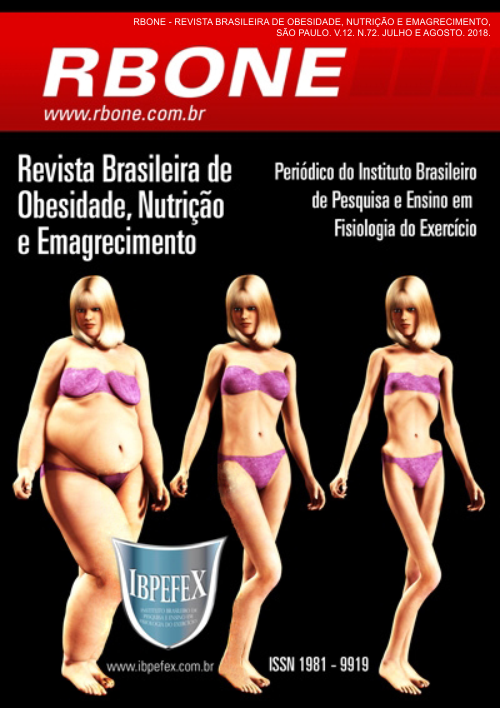Association between nutritional status, screen consumption hours and physical activity in adolescents
Abstract
The objective of this research was to associate the hours of screen consumption and physical activity with the BMI of adolescent schoolchildren from a private school in Joinville-SC. Materials and Methods - Participants were selected by probabilistic sampling of convenience. We evaluated the anthropometric index (BMI / age), the food consumption through a Food Frequency Questionnaire and the time of screen consumption and physical activity. The data was tabulated in Microsoft Excel Office 2010 and analyzed according to the descriptive statistics. Results - Out of the total number of adolescents (n = 47) investigated, 59.57% were girls, all students from a private school in Joinville / SC. Regarding the anthropometric evaluation, according to BMI / age, the mean of the girls was found in the P50 percentile with a mean BMI of 18.26 kg / m2; and the boys were between the P50 and P85 percentiles with a mean BMI of 19.65 kg / m2. About 80.85% of the adolescents made snacks between the main meals (lunch and dinner); 46.80% had four meals a day; 25.53% five or more meals daily; 27.65% two / three meals a day. In the school environment, the consumption of filled cookies (27.65%), fruits (23.40%), roasted salted (23.40%) were emphasized. It was observed that 51.06% of the investigated adolescents spent more than three hours watching television, playing games or surfing the internet. According to the WHO, the consumption of food with a high energy density is greater while it is in front of TV, video game and internet. Conclusion - The results obtained contributed to know the nutritional status of the population investigated, and the factors that can condition them.
References
-Barreto, A.G.S.; Silva, M.I.; Gabriel, N.V.A.; Pereira, S.M.G. Hábitos obesogênicos e prevalência de obesidade em população adulta na Bahia. Revista Brasileira de Obesidade, Nutrição e Emagrecimento. São Paulo. Vol. 3. Núm. 14. p. 165-174. 2009. Disponível em: <http://www.rbone.com.br/index.php/rbone/article/view/143>
-Brasil. Ministério da Saúde. Vigilância Alimentar e Nutricional-SISVAN: orientações básicas para a coleta, processamento, analise dos dados e informação em serviços de saúde. Brasília. Ministério da Saúde. 2011.
-Carvalho, C.A.; Simão, M.T.J.; Fonseca, M.C.; Andrade, R.G.; Ferreira, M.S.G.; Silva, A.F.; Souza, I.P.R.; Fernandes, B.S. Consumo de energia e macronutrientes no lanche escolar de adolescentes de São Luís, Maranhão, Brasil. Caderno de Saúde Coletiva. Vol. 22. Núm. 2. p. 212-217. 2014.
-Enes, C.C.; Slater, B. Obesidade na adolescência e seus principais fatores determinantes. Revista Brasileira Epidemiologia. Vol. 13. Núm. 1. p. 163-171. 2010.
-Farias, E.S.; Guerra-Junior, G.; Petroski, E.L. Estado nutricional de escolares em Porto Velho, Rondônia. Revista de Nutrição. Vol. 21. Núm. 4. p. 401-409. 2008.
-Instituto Brasileiro de Geografia e Estatística(IBGE). Pesquisa Nacional de Saúde de Escolar 2009 (PeNSE). Avaliação do estado nutricional dos escolares do 9° ano do ensino fundamental: municípios das capitais e Distrito Federal. Rio de Janeiro. Instituto Brasileiro de Geografia e Estatísticas. 2010.
-Mishima, F.K.T, Barbieri, V. O brincar criativo e a obesidade infantil. Scielo Brasil. Vol. 14. Núm. 3. p. 249-255. 2009.
-Mello, E.D.; Luft, V.C, Meyer, F. Obesidade infantil: como podemos ser eficazes? Jornal de Pediatria. Vol. 80. Núm. 3. p. 173-182. 2004.
-Nozaki, V.T.; Tanaka, R.A. Perfil Nutricional e Consumo Alimentar de Adolescentes Participantes do Núcleo de Pratica de Atletismo. Revista Saúde e Pesquisa. Vol. 2. Núm. 3. p. 371-377. 2009.
-Pegolo, G.E.; Silva, M.V. Estado Nutricional de Escolares da Rede Pública de Ensino de Piedade, SP. Segurança Alimentar e Nutricional. Vol. 15. Núm. 1. p. 76-85. 2008.
-Silva, G.A.P.; Balaban, G.; Motta, M.E.F.A. Prevalência de Sobrepeso e Obesidade em Crianças e Adolescentes de Diferentes Condições Socioeconômicos. Revista Brasileira de Saúde Materno Infantil. Vol. 5. Núm. 1. p. 53-59. 2005.
-Vasconcellos, M.B.; Anjos, L.A.; Vasconcellos, M.T.L. Estado nutricional e tempo de tela de escolares da Rede Pública de Ensino Fundamental de Niterói, Rio de Janeiro, Brasil. Caderno de Saúde Pública. Vol. 29. Núm. 4. p. 713-722. 2013.
-World Health Organization(WHO). Growth reference data for 5-19 years. 2007.
Authors who publish in this journal agree to the following terms:
- Authors retain the copyright and grant the journal the right of first publication, with work simultaneously licensed under the Creative Commons Attribution License BY-NC which allows the sharing of the work with acknowledgment of the authorship of the work and initial publication in this journal.
- Authors are authorized to enter into additional contracts separately for non-exclusive distribution of the version of the work published in this journal (eg, publishing in institutional repository or book chapter), with acknowledgment of authorship and initial publication in this journal.
- Authors are allowed and encouraged to post and distribute their work online (eg, in institutional repositories or on their personal page) at any point before or during the editorial process, as this can bring about productive change as well as increase impact and impact. citation of published work (See The Effect of Free Access).






